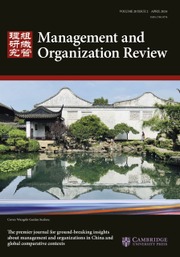It is in the beautiful August weather of Seattle that I am compiling this issue. To continue with what was done in the last issue, we open with the second editorial essay on how to conduct Chinese management research (Zhang, 2025). It discusses three approaches – counterintuitive, contrasting, and theory integration – to make theoretical contributions through contextualization. Following that is a perspective paper (Eesley, Tian, Yang, & Lee, 2025) that examines how university curriculum reforms shape entrepreneurial tendencies among alumni. The authors find that increased educational choice fosters entrepreneurship but also exacerbates inequalities, disproportionately benefiting those with preexisting advantages. They then offer implications for designing more equitable educational policies.
The two regular articles in this issue are both related to business networks while manifested in different business domains. One focuses on alliance partner repeatedness and its portfolio reconfiguration (Xie, Gao, Li, Bi, & Stevens, 2025), in which the authors find that higher partner repeatedness drives firms to reconfigure their alliance by reintroducing previous partners, rather than introducing new partners or dropping the active ones. The other article studies the role of family formal business networks in the relationship between family ownership and firm digital transformation (Ko, Chen, Liu, Wu, & Jiang, 2025). The authors find a negative relationship between family ownership and firm digital transformation efforts, but more importantly, this negative relationship weakens when family firms participate in informal business networks or involve multiple next-generation members in leadership positions.
Finally, we have three exciting articles for the special issue on New Technology and OB/HRM in China. The guest editors for this special issue, Ning Li, Sam Kai Chi Yam, Wei He, and Helen Zhao, have worked for more than three years to develop it. Leveraging the rich archival unobtrusive data on digital platforms in various companies, the authors employ innovative methods – digital-context experiments, real-time behavioral tracking, and machine-learning-assisted theory building – to convert granular data into valuable management knowledge. The first article (Liu, Huang, Ju, Shi, & Xu, 2025) explores leader smile emoji use and its influence on follower perception of the leader and reveals divergent effects due to different psychological mechanisms. The second article (Pan, Ji, Cao, Li, & Hu, 2025) investigates the temporal patterns of employee work productivity before, during, and after a crisis event in a high-tech off campus tutoring company. More importantly, it studies how leader-member online communication frequency influences the productivity trajectories during crisis adaptation. The last article (Gao, Luo, Wang, & Li, 2025) uses a machine learning inductive method to uncover curvilinear interactive patterns between knowledge diversity and network density in fostering team innovation in a prominent high-technology firm in China.
I hope you will gain unique insights from every article in this issue. I also hope you enjoy the rest of summer!
With gratitude,

Xiao-Ping Chen, Editor of MOR

